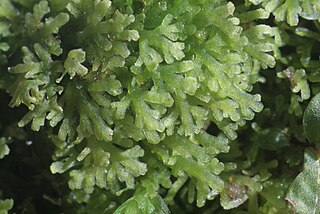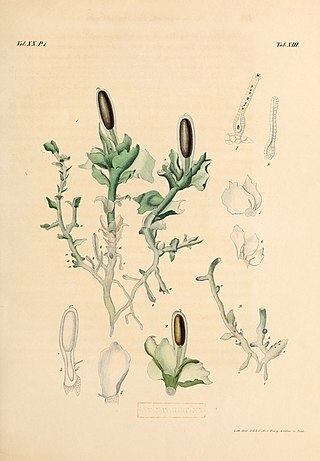
Jungermanniales is the largest order of liverworts. They are distinctive among the liverworts for having thin leaf-like flaps on either side of the stem. Most other liverworts are thalloid, with no leaves. Due to their dorsiventral organization and scale-like, overlapping leaves, the Jungermanniales are sometimes called "scale-mosses".

Metzgeriales is an order of liverworts. The group is sometimes called the simple thalloid liverworts: "thalloid" because the members lack structures resembling stems or leaves, and "simple" because their tissues are thin and relatively undifferentiated. All species in the order have a small gametophyte stage and a smaller, relatively short-lived, spore-bearing stage. Although these plants are almost entirely restricted to regions with high humidity or readily available moisture, the group as a whole is widely distributed, and occurs on every continent except Antarctica.

Jungermanniopsida is the largest of three classes within the division Marchantiophyta (liverworts).

Lepidoziaceae is a family of leafy liverworts. It is a group of small plants that are widely distributed.

Aneuraceae is a family of thallose liverworts in the order Metzgeriales. Most species are very small with narrow, branching thalli.

Biantheridion is a genus of liverwort in the family Anastrophyllaceae. Its only accepted species is Biantheridion undulifolium the marsh flapwort, or marsh earwort. It is found in Austria, China, the Czech Republic, Denmark, Finland, France, Germany, Greenland, North Korea, Norway, Poland, Russia, Sweden, Switzerland, and the United Kingdom. Its natural habitat is swamps. It is threatened by habitat loss.
Schistochila vitreocincta is a species of liverwort in the family Schistochilaceae. Under its synonym Perssoniella vitreocincta it was the only species in the monotypic genus Perssoniella and family Perssoniellaceae. It is endemic to New Caledonia. Its natural habitat is subtropical or tropical dry forests.
Lejeunea drehwaldii, synonym Sphaerolejeunea umbilicata, is a species of liverworts in the family Lejeuneaceae. It is endemic to Colombia. Its natural habitat is subtropical or tropical moist lowland forests.

Herbertaceae is a family of liverworts. The family consists of the genera Herbertus, Schisma and Triandrophyllum. The genus HerpocladiumMitten, 1873 was later merged into the genus Herbertus.
Cryptothallus is a previously recognized genus of liverworts in the family Aneuraceae. The plants are small, and are white to pale green as a result of lacking chlorophyll. This feature led to the creation of a separate genus. The morphology of species assigned to Cryptothallus is very similar to that of Aneura. As a result, Karen Renzaglia in 1982 suggested that the only species then placed in the genus, Cryptothallus mirabilis, may be considered "merely as an achlorophyllous species of Aneura." Wickett and Goffinet argued the same position on the basis of sequences of nuclear, mitochondrial, and plastid DNA, and moved Cryptothallus mirabilis to Aneura. A 2010 molecular phylogenetic study confirmed the position of Cryptothallus within Aneura. This was accepted in the 2016 world checklist of hornworts and liverworts.

Pleurozia is the only genus of liverworts in the family Pleuroziaceae, which is now classified in its own order Pleuroziales, but was previously included in a broader circumscription of the Jungermanniales. The genus includes twelve species, and as a whole is both physically distinctive and widely distributed.
Phycolepidozia is a genus of liverwort in the family Cephaloziellaceae. It contains two species:
Pseudolepicoleaceae is a family of liverworts in the order Jungermanniales.

Solenostomataceae is a family of liverworts in the order Jungermanniales.
Acrobolbus, synonyms including Marsupidium, is a liverwort genus in the family Acrobolbaceae.
Acrobolbus epiphytus is a liverwort species in the genus Acrobolbus. It occurs in New Zealand.

Cephaloziaceae is a family of liverworts.

Haplomitrium is a genus of liverworts.
Lepicoleaceae is a family of liverworts belonging to the order Jungermanniales.
Lepicolea is a genus of liverworts belonging to the family Lepicoleaceae.










